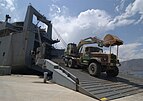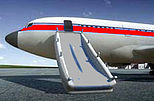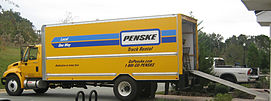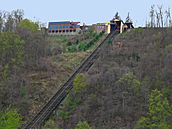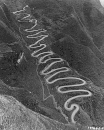Inclined plane
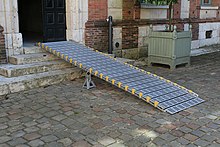
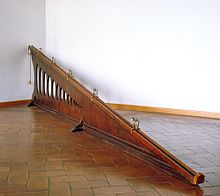
An inclined plane, also known as a ramp, is a flat supporting surface tilted at an angle from the
Moving an object up an inclined plane requires less
The
Two other simple machines are often considered to be derived from the inclined plane.
The term may also refer to a specific implementation; a straight ramp cut into a steep hillside for transporting goods up and down the hill. This may include cars on rails or pulled up by a cable system; a funicular or cable railway, such as the Johnstown Inclined Plane.
Uses
Inclined planes are widely used in the form of loading ramps to load and unload goods on trucks, ships and planes.
Other inclined planes are built into permanent structures. Roads for vehicles and railroads have inclined planes in the form of gradual slopes, ramps, and
History
| Stevin's proof |

As pointed out by Dijksterhuis,[13] Stevin's argument is not completely tight. The forces exerted by the hanging part of the chain need not be symmetrical because the hanging part need not retain its shape when let go. Even if the chain is released with a zero angular momentum, motion including oscillations is possible unless the chain is initially in its equilibrium configuration, a supposition which would make the argument circular. |
Inclined planes have been used by people since prehistoric times to move heavy objects.[14][15] The sloping roads and causeways built by ancient civilizations such as the Romans are examples of early inclined planes that have survived, and show that they understood the value of this device for moving things uphill. The heavy stones used in ancient stone structures such as Stonehenge[16] are believed to have been moved and set in place using inclined planes made of earth,[17] although it is hard to find evidence of such temporary building ramps. The Egyptian pyramids were constructed using inclined planes,[18][19][20] Siege ramps enabled ancient armies to surmount fortress walls. The ancient Greeks constructed a paved ramp 6 km (3.7 miles) long, the Diolkos, to drag ships overland across the Isthmus of Corinth.[4]
However the inclined plane was the last of the six classic
It was not until the
The first elementary rules of sliding
Terminology
Slope
The mechanical advantage of an inclined plane depends on its slope, meaning its gradient or steepness. The smaller the slope, the larger the mechanical advantage, and the smaller the force needed to raise a given weight. A plane's slope s is equal to the difference in height between its two ends, or "rise", divided by its horizontal length, or "run".[31] It can also be expressed by the angle the plane makes with the horizontal, .

Mechanical advantage
The mechanical advantage of a simple machine is defined as the ratio of the output force exerted on the load to the input force applied. For the inclined plane the output load force is just the gravitational force of the load object on the plane, its weight . The input force is the force exerted on the object, parallel to the plane, to move it up the plane. The mechanical advantage is
The of an ideal inclined plane without friction is sometimes called ideal mechanical advantage while the MA when friction is included is called the actual mechanical advantage .[32]
Frictionless inclined plane

If there is no friction between the object being moved and the plane, the device is called an ideal inclined plane. This condition might be approached if the object is rolling like a barrel, or supported on wheels or casters. Due to conservation of energy, for a frictionless inclined plane the work done on the load lifting it, , is equal to the work done by the input force, [33][34][35]
Work is defined as the force multiplied by the displacement an object moves. The work done on the load is equal to its weight multiplied by the vertical displacement it rises, which is the "rise" of the inclined plane
The input work is equal to the force on the object times the diagonal length of the inclined plane.
Substituting these values into the conservation of energy equation above and rearranging
To express the mechanical advantage by the angle of the plane,[34] it can be seen from the diagram (above) that
So
So the mechanical advantage of a frictionless inclined plane is equal to the reciprocal of the sine of the slope angle. The input force from this equation is the force needed to hold the load motionless on the inclined plane, or push it up at a constant velocity. If the input force is greater than this, the load will accelerate up the plane. If the force is less, it will accelerate down the plane.
Inclined plane with friction
Where there is friction between the plane and the load, as for example with a heavy box being slid up a ramp, some of the work applied by the input force is dissipated as heat by friction, , so less work is done on the load. Due to conservation of energy, the sum of the output work and the frictional energy losses is equal to the input work
Therefore, more input force is required, and the mechanical advantage is lower, than if friction were not present. With friction, the load will only move if the net force parallel to the surface is greater than the frictional force opposing it.[8][36][37] The maximum friction force is given by
where is the normal force between the load and the plane, directed normal to the surface, and is the
With friction, there is always some range of input force for which the load is stationary, neither sliding up or down the plane, whereas with a frictionless inclined plane there is only one particular value of input force for which the load is stationary.
Analysis

A load resting on an inclined plane, when considered as a free body has three forces acting on it:[8][36][37]
- The applied force, exerted on the load to move it, which acts parallel to the inclined plane.
- The weight of the load, , which acts vertically downwards
- The force of the plane on the load. This can be resolved into two components:
- The normal force of the inclined plane on the load, supporting it. This is directed perpendicular (normal) to the surface.
- The frictional force, of the plane on the load acts parallel to the surface, and is always in a direction opposite to the motion of the object. It is equal to the normal force multiplied by the coefficient of static frictionμ between the two surfaces.
- The normal force of the inclined plane on the load, supporting it. This is directed perpendicular (
Using
- Uphill motion: The total force on the load is toward the uphill side, so the frictional force is directed down the plane, opposing the input force.
|
Derivation of mechanical advantage for uphill motion The equilibrium equations for forces parallel and perpendicular to the plane are
|
- The mechanical advantage is
- where . This is the condition for impending motion up the inclined plane. If the applied force Fi is greater than given by this equation, the load will move up the plane.
- Downhill motion: The total force on the load is toward the downhill side, so the frictional force is directed up the plane.
|
Derivation of mechanical advantage for downhill motion The equilibrium equations are
|
- The mechanical advantage is
- This is the condition for impending motion down the plane; if the applied force Fi is less than given in this equation, the load will slide down the plane. There are three cases:
- : The mechanical advantage is negative. In the absence of applied force the load will remain motionless, and requires some negative (downhill) applied force to slide down.
- : The 'angle of repose'. The mechanical advantage is infinite. With no applied force, load will not slide, but the slightest negative (downhill) force will cause it to slide.
- : The mechanical advantage is positive. In the absence of applied force the load will slide down the plane, and requires some positive (uphill) force to hold it motionless
Mechanical advantage using power

The mechanical advantage of an inclined plane is the ratio of the weight of the load on the ramp to the force required to pull it up the ramp. If energy is not dissipated or stored in the movement of the load, then this mechanical advantage can be computed from the dimensions of the ramp.
In order to show this, let the position r of a rail car on along the ramp with an angle, θ, above the horizontal be given by
where R is the distance along the ramp. The velocity of the car up the ramp is now
Because there are no losses, the power used by force F to move the load up the ramp equals the power out, which is the vertical lift of the weight W of the load.
The input power pulling the car up the ramp is given by
and the power out is
Equate the power in to the power out to obtain the mechanical advantage as
The mechanical advantage of an inclined plane can also be calculated from the ratio of length of the ramp L to its height H, because the sine of the angle of the ramp is given by
therefore,
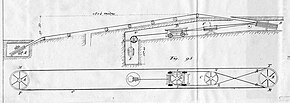
Example: If the height of a ramp is H = 1 meter and its length is L = 5 meters, then the mechanical advantage is
which means that a 20 lb force will lift a 100 lb load.
The Liverpool Minard inclined plane has the dimensions 1804 meters by 37.50 meters, which provides a mechanical advantage of
so a 100 lb tension force on the cable will lift a 4810 lb load. The grade of this incline is 2%, which means the angle θ is small enough that sin θ≈tan θ.
See also
- Canal inclined plane
- Grade (slope)
- Inclined plane railroad
- Ramp function
- Schiefe Ebene
- Stairs
References
- ^ ISBN 978-981-06-2002-8.
- ISBN 978-0-87779-809-5.
inclined plane definition dictionary.
- ^ a b c d "The Inclined Plane". Math and science activity center. Edinformatics. 1999. Retrieved March 11, 2012.
- ^ ISBN 978-1-4329-2317-4.
- ^ ISBN 978-1-55863-060-4.
- ^ a b Reilly, Travis (November 24, 2011). "Lesson 04:Slide Right on By Using an Inclined Plane". Teach Engineering. College of Engineering, Univ. of Colorado at Boulder. Archived from the original on May 8, 2012. Retrieved September 8, 2012.
- ISBN 978-0-412-98421-1.
angle of friction [mech.] in the study of bodies sliding on plane surfaces, the angle between the perpendicular to the surface and the resultant force (between the body and the surface) when the body begins to slide. angle of repose [s.m.] for any given granular material the steepest angle to the horizontal at which a heaped surface will stand in stated conditions.
- ^ ISBN 978-81-203-3134-1.
Angle of repose is the limiting angle of inclination of a plane when a body, placed on the inclined plane, just starts sliding down the plane.
- ISBN 978-0-8160-7011-4.
- ^ ISBN 978-90-481-9090-4.
- ISBN 978-1-84564-391-1.
- ^ ISBN 978-0-465-02493-3.
- ^ E.J.Dijksterhuis: Simon Stevin 1943
- ISBN 978-0-7618-3702-2.
- ^ Dutch, Steven (1999). "Pre-Greek Accomplishments". Legacy of the Ancient World. Prof. Steve Dutch's page, Univ. of Wisconsin at Green Bay. Archived from the original on August 21, 2016. Retrieved March 13, 2012.
- ISBN 978-1-85669-371-4.
- ISBN 978-1-4068-2203-8.
- ^ Thomas, Burke (2005). "Transport and the Inclined Plane". Construction of the Giza Pyramids. world-mysteries.com. Archived from the original on March 13, 2012. Retrieved March 10, 2012.
- ISBN 978-0-8061-3342-3.
- ISBN 978-0-88029-456-0.
- ^ a b Karl von Langsdorf (1826) Machinenkunde, quoted in Reuleaux, Franz (1876). The kinematics of machinery: Outlines of a theory of machines. MacMillan. pp. 604.
- ISBN 978-0-486-25593-4.
- ^ Heath, Thomas Little (1921). A History of Greek Mathematics, Vol. 2. UK: The Clarendon Press. pp. 349, 433–434.
- ^ ISBN 978-1-4020-5966-7.
- ^ ISBN 978-0-8018-8426-9.
- ^ ISBN 978-0-470-63056-3.
- ISBN 978-0-486-25593-4.
- ISBN 978-0-521-58841-6.
- ^ ISBN 978-0-7923-9133-3.
- ISBN 978-981-238-062-3.
- ^ ISBN 978-1-4354-2836-2.
- ISBN 978-1-59257-081-2.
- ^ Nave, Carl R. (2010). "The Incline". Hyperphysics. Dept. of Physics and Astronomy, Georgia State Univ. Retrieved September 8, 2012.
- ^ a b Martin, Lori (2010). "Lab Mech14:The Inclined Plane - A Simple Machine" (PDF). Science in Motion. Westminster College. Retrieved September 8, 2012.
- ISBN 978-81-317-2843-7.
- ^ ISBN 978-81-7008-094-7.
- ^ ISBN 978-81-318-0295-3.


